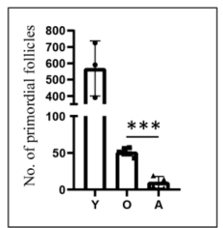Key Points:
- The senolytic ABT-263 reduces structures in the ovaries called follicles, which may lead to infertility in older mice.
- Despite this, other senolytics are currently being tested to treat several age-related diseases.
Senolytics are among the most promising age-reversal compounds. They eliminate senescent cells, which are associated with mediating chronic diseases like cardiovascular and neurodegenerative diseases. However, Chinese scientists have recently discovered that a senolytic compound called ABT-263 accelerates ovarian aging in female mice. These findings suggest that older women wishing to conceive should not take certain senolytic compounds.
Senolytic ABT-263 Accelerates Ovary Aging
A previous study showed that when administered to younger (3-month-old) mice, ABT-263 delays ovarian aging. However, humans are more likely to take senolytics later in life, such as during middle age, to delay aging. For this reason, researchers administered ABT-263 to aged (16-month-old, equivalent to approximately 50 human years) mice.
These ABT-263-treated aged mice were compared to young mice and untreated aged mice. The results showed that, compared to the young mice, the untreated aged mice had fewer follicles — the structures that support the growth of oocytes. Moreover, the ABT-263-treated aged mice had even less follicles than the untreated aged mice. These findings suggest that ABT-263 accelerates ovarian aging by reducing ovarian follicle numbers.

A reduction in follicles is a hallmark of ovarian aging, and studies suggest that senescent follicles increase with age. However, because ABT-263 is a senolytic, it destroys senescent follicles. It follows that with increasing age, ABT-263 becomes more determinantal because it destroys the already low number of follicles. Consequently, without adequate levels of functional follicles, a viable oocyte is less likely to mature, which can lead to infertility.
In addition to reducing follicle numbers, ABT-263 was shown to reduce ovary size. In one ABT-263-treated mouse, the left ovary was missing completely. Furthermore, some ovaries in the ABT-263-treated mice had blood clots and ruptures, suggesting that ABT-263 damages the ovaries of aged mice. Still, ABT-263 was also shown to have positive effects such as reducing the ovarian scarring. Nevertheless, ABT-263 treatment appears to be detrimental to ovarian health when administered to older mice.

Who Should Take Senolytics?
A wide variety of senolytics have been explored in preclinical studies and are part of ongoing clinical trials, some of which are FDA-approved drugs. For example, ABT-263, or navitoclax, is an experimental cancer drug. Moreover, each type of senolytic targets a different cellular pathway. For example, ABT-263 targets cell death via the Bcl-2 pathway.
For the above reasons, each type of senolytic may have a different effect on different organs. ABT-263 targets ovarian cancer, suggesting this senolytic may affect the ovaries more than others. Other senolytics are naturally occurring molecules, such as fisetin, that may not target specific pathways like FDA-approved drugs. Natural senolytics target oxidative stress, an underlying biological driver of aging. Therefore, these senolytics may not promote female infertility like ABT-263.
Together, senolytics may potentially be used to treat age-related diseases, including lung disease, kidney disease, Alzheimer’s disease, arthritis, macular degeneration, and cancer. Naturally occurring senolytics can be found in most plant-based foods. For example, quercetin is a senolytic that can be found in green tea, coffee, berries, apples, broccoli, grapes, and red wine. These senolytics can also be found in supplment form at therapeutic doses.